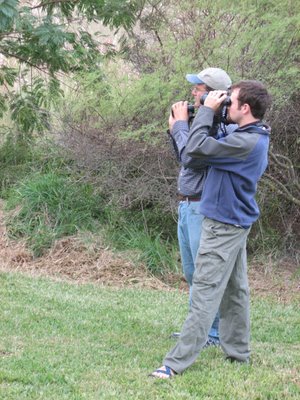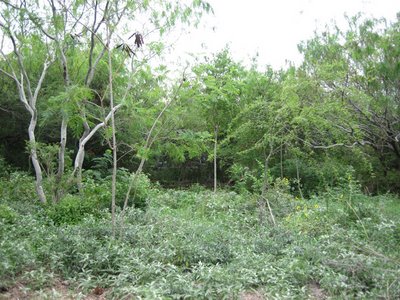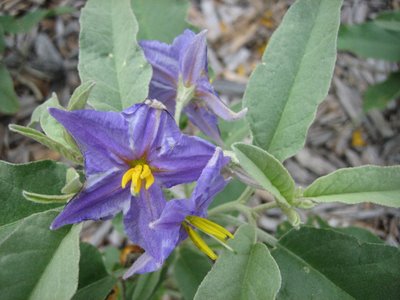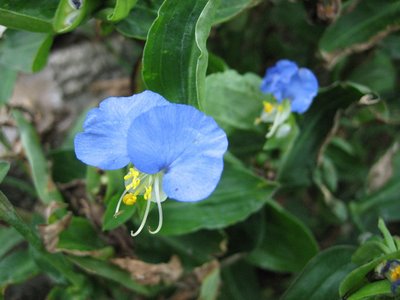RGV: Sunday
On the last day of the Rio Grande Valley Birding Festival, I set off for South Padre Island with four leaders--Paul Lehman, Jay Packer, Derek Muschalek and Mike Hannisian--and a small group of participants. The reduced group size felt like a delightful change from the previous field trips' full capacity.
When the bus pulled into the northern parking lot behind the convention center, we saw American White Pelican, Brown Pelican (I'd never seen how much smaller they are in comparison to AWPE), American Oystercatcher (love that carrot bill!), Short-billed Dowitcher, Great Blue Heron, Marbled Godwit, Reddish Egret, western Willet, Killdeer, Royal Tern, Laughing Gull, Franklin's Gull, Northen Pintail, Greater Scaup, Belted Kingfisher (hovering like a tern before plunging toward a fish in the water!) and Northern Harrier with its white rump.
After walking to the southern side of the convention center, we encountered the thickets and water that typically draw migrants. The grounds include three separate areas landscaped to attract birds along the southern and eastern edges of the facility.

In these areas, we saw Northern Parula, Gray Catbird, Northern Mockingbird, Golden-crowned Kinglet, Couch's Kingbird and House Wren. It was a slow day for migrants and a bit of a disappointment for those who'd anticipate more activity, given the previous day's cold front.
Jay Packer (below on the right, with Paul Lehman) and I watched a kingbird eat an entire monarch butterfly. Some birds remove the wings by beating the insect against a branch, then eat just the body. This bird ate the entire butterfly, wings and all. Jay mentioned that he'd seen photos in a biology textbook of a bird that ate a monarch and promptly threw up, so he and I waited to see if the kingbird experienced the butterfly in reverse. It apparently didn't.

While strolling on the boardwalk, I got to see Tricolored Heron, Common Moorhen, Redhead, Cooper's Hawk, Red-winged Blackbird, Forster's Tern, Common Tern, Great Egret and Snowy Egret.

Then we boarded the bus and headed south into town and onto Sheepshead Street, where the Valley Land Fund lots provide a birdscaped haven amid the houses and businesses. (Thank you, Billy Snyder!)

Amid and above the vegetation, we saw Pine Warbler, female Indigo Bunting, Yellow-rumped Warbler and... four Cedar Waxwings. The latter elicited delighted reactions from some leaders and participants.
Any guesses on the names of these flowers?


UPDATE: Thank you to the fine fellow who said the top flower is a silverleaf nightshade while the bottom flower is a blue dayflower.
When the bus pulled into the northern parking lot behind the convention center, we saw American White Pelican, Brown Pelican (I'd never seen how much smaller they are in comparison to AWPE), American Oystercatcher (love that carrot bill!), Short-billed Dowitcher, Great Blue Heron, Marbled Godwit, Reddish Egret, western Willet, Killdeer, Royal Tern, Laughing Gull, Franklin's Gull, Northen Pintail, Greater Scaup, Belted Kingfisher (hovering like a tern before plunging toward a fish in the water!) and Northern Harrier with its white rump.
After walking to the southern side of the convention center, we encountered the thickets and water that typically draw migrants. The grounds include three separate areas landscaped to attract birds along the southern and eastern edges of the facility.

In these areas, we saw Northern Parula, Gray Catbird, Northern Mockingbird, Golden-crowned Kinglet, Couch's Kingbird and House Wren. It was a slow day for migrants and a bit of a disappointment for those who'd anticipate more activity, given the previous day's cold front.
Jay Packer (below on the right, with Paul Lehman) and I watched a kingbird eat an entire monarch butterfly. Some birds remove the wings by beating the insect against a branch, then eat just the body. This bird ate the entire butterfly, wings and all. Jay mentioned that he'd seen photos in a biology textbook of a bird that ate a monarch and promptly threw up, so he and I waited to see if the kingbird experienced the butterfly in reverse. It apparently didn't.

While strolling on the boardwalk, I got to see Tricolored Heron, Common Moorhen, Redhead, Cooper's Hawk, Red-winged Blackbird, Forster's Tern, Common Tern, Great Egret and Snowy Egret.

Then we boarded the bus and headed south into town and onto Sheepshead Street, where the Valley Land Fund lots provide a birdscaped haven amid the houses and businesses. (Thank you, Billy Snyder!)

Amid and above the vegetation, we saw Pine Warbler, female Indigo Bunting, Yellow-rumped Warbler and... four Cedar Waxwings. The latter elicited delighted reactions from some leaders and participants.
Any guesses on the names of these flowers?


UPDATE: Thank you to the fine fellow who said the top flower is a silverleaf nightshade while the bottom flower is a blue dayflower.


0 Comments:
Post a Comment
<< Home